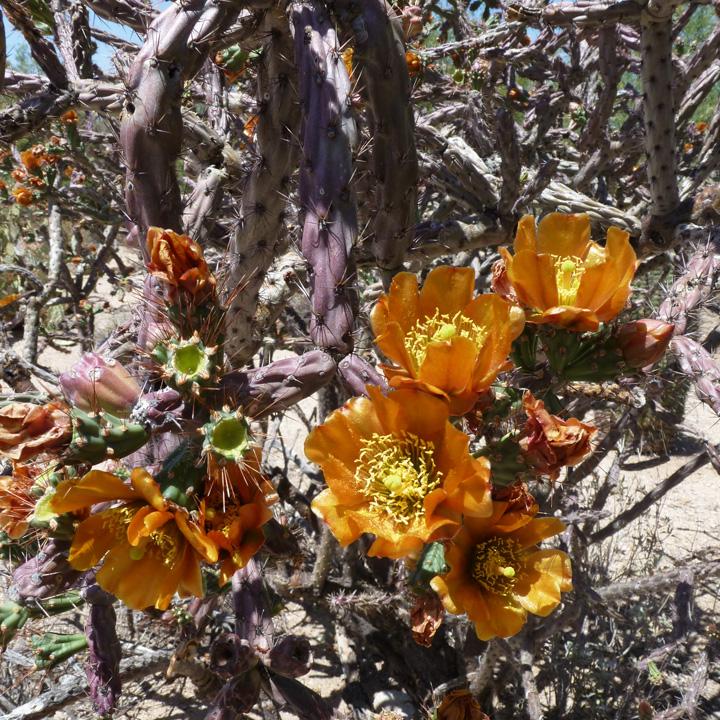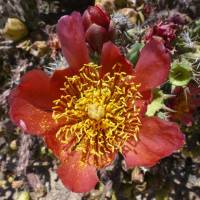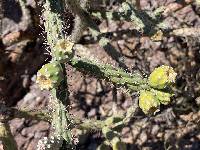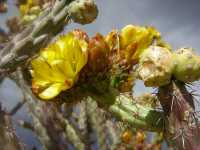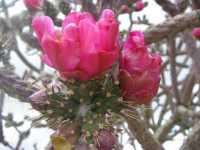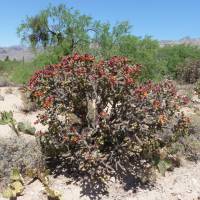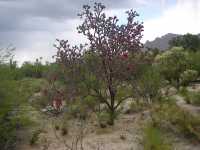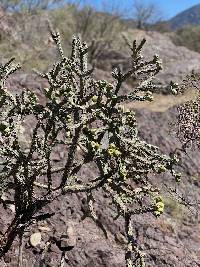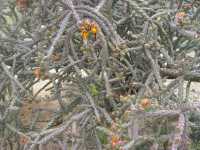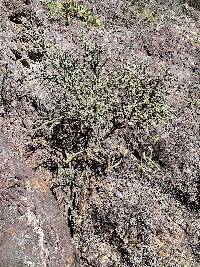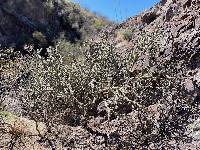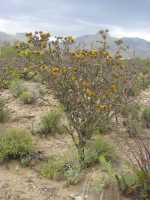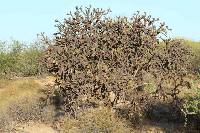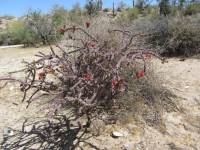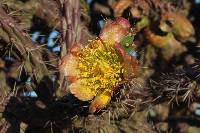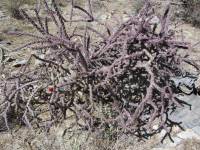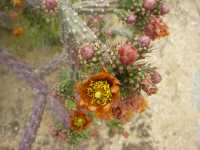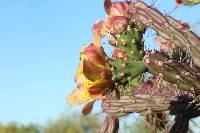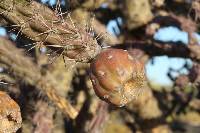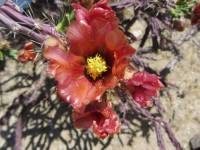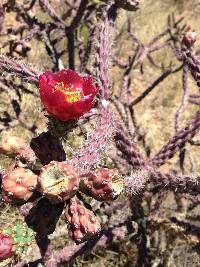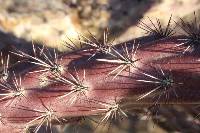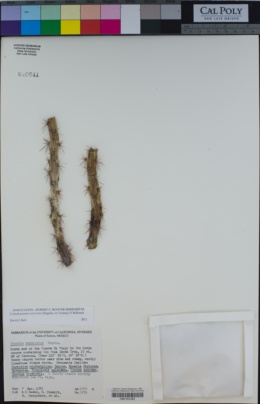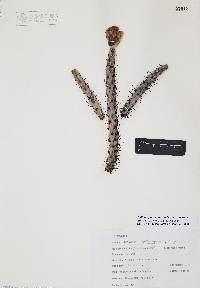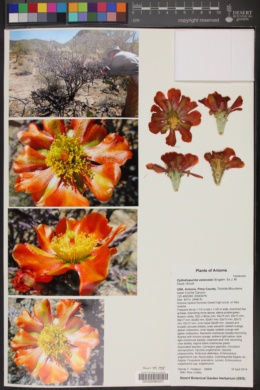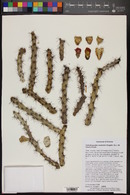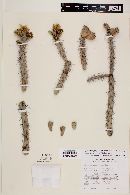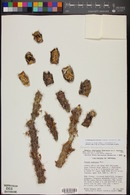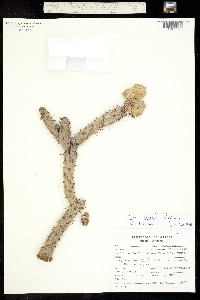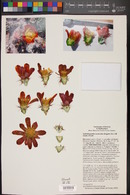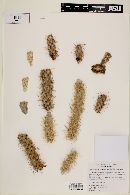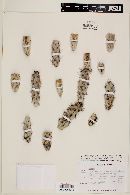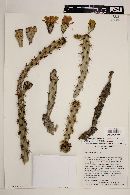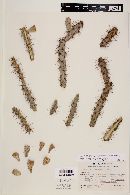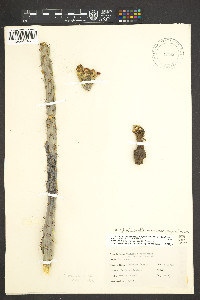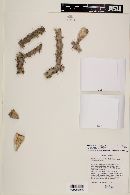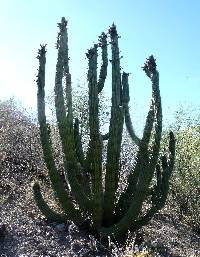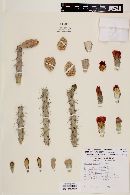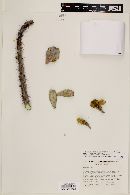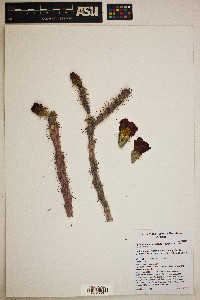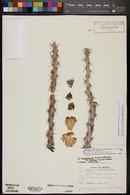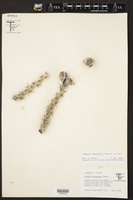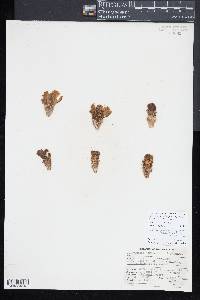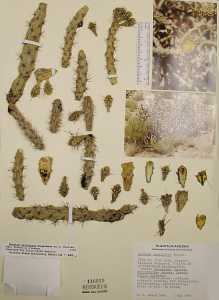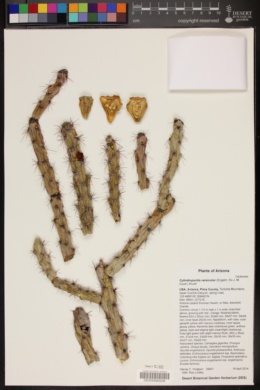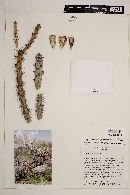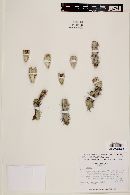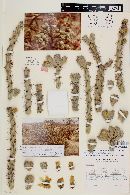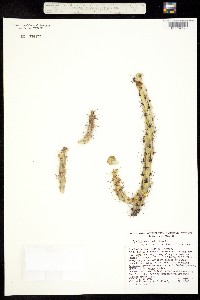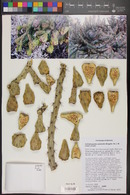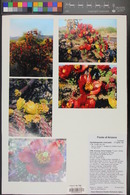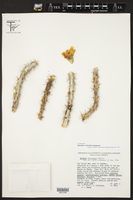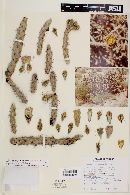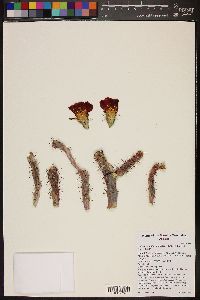Cylindropuntia versicolor
|
|
|
|
Family: Cactaceae
Stag-Horn Cholla, more...staghorn cholla
[Cylindropuntia thurberi subsp. versicolor, moreCylindropuntia thurberi var. versicolor , Opuntia thurberi subsp. versicolor (Engelm. ex J.M. Coult.) Felger, Opuntia thurberi var. versicolor , Opuntia versicolor Engelm. ex Coult., Opuntia versicolor var. versicolor Engelm. ex J.M. Coult., Opuntia versicolor var. violacea Engelm. ex J.M. Coult.] |
Trees or shrubs, openly branching at acute angles, to 2 m. Stem segments whorled or subwhorled, purple to green-purple, 4-18 × 1-2 cm; tubercles prominent, elongate-oval, 1-2(-2.5) cm; areoles subcircular, 3.5-4 mm diam.; wool tan to brown, aging gray. Spines 6-8 per areole (1-2 bristlelike spines) increasing with time, well distributed along stem, slightly interlacing with spines of adjacent areoles, short; abaxial spines usually reflexed, whitish, pinkish to red-brown, lightly flattened, the longest 10-18 mm; adaxial spines erect or spreading, rich red-brown, gray coated basally, subterete, 6-11 mm; sheaths grayish, tipped brown or yellow to golden Glochids in small adaxial tuft or crescent, dark yellow, to 1 mm. Flowers: inner tepals yellow-green, yellow to gold or bronze, or red to rose or magenta, spatulate, apiculate; filaments yellowish green; anthers yellow; style whitish to pale bronze; stigma lobes whitish. Fruits often proliferating, yellowish green or tinged red to purple, often stipitate, obovate, 25-40 × 10-20 mm, leathery-fleshy, tuberculate or smooth, essentially spineless; tubercles prominent, at first, subequal in length or proximal ones longer, fertile ones swelling and becoming smooth; umbilicus to 9 mm deep; areoles 20-30. Seeds yellowish, polygonal in outline, warped, 3.5-5.5 × 2.5-5 mm, sides nearly flattened with depressions and protrusions to angular subspheric; girdle smooth or in a groove. 2n = 22. Flowering spring (Apr-Jun). Sonoran Desert, desert scrub, flats, washes, rocky hillsides, canyons; 600-1300 m; Ariz.; Mexico (Sonora). Cylindropuntia versicolor forms hybrids with C. acanthocarpa var. major, C. arbuscula (= C. ×vivipara), C. leptocaulis (see discussion under 3. C. ×tetracantha), and C. spinosior (= C. ×grantiorum P. V. Heath). Cylindropuntia ×grantiorum, found in eastern to south-central Arizona, is intermediate between the parental species in values for the number of spines per stem areole, stem segment diameter and color, and fruit tubercles. The hybrids between C. versicolor and C. acanthocarpa var. major, which occur in south-central Arizona, have fleshy, tuberculate fruits, often with one or two short permanent spines at apex and longer and more numerous spines per stem areole. Cylindropuntia versicolor itself may be of hybrid origin.
Plant: tree or shrub, openly branching at acute angles, to 2 m tall; STEM segments purple to green-purple, 4-18 cm long, 1-2 cm in diam.; tubercles prominent, elongate-oval, 1-2(-2.5) cm long. AREOLES tan- to brown-felty, aging gray, subcircular, 3.5-4 mm in diam Leaves: SPINES well distributed along stem, slightly interlacing, 6-8 per areole (more numerous in older areoles), with 0-2 bristle-spines, the sheaths grayish tipped brown, yellow to golden; distal spines rich red-brown, gray-coated below, erect-spreading, subterete, 6-11 mm long; basal spines whitish, pinkish to red brown, mostly reflexed, lightly flattened, longest 10-18 mm long. GLOCHIDS dark yellow, in a small apical tuft or crescent, to 1 mm long Flowers: inner tepals yellow-green, yellow to gold and bronze or red to rose or magenta, spatulate, apiculate, 20-25 mm long; filaments yellowish green, the anthers yellow; style whitish to pale bronze; stigmas whitish Fruit: yellowish green or tinged red to purple, leathery-fleshy, obovate and often stipitate, essentially spineless, often proliferating, 2.5-4 cm long, 1-2 cm in diam., at first the tubercles prominent, subequal in length or lower ones longer, but swelling and becoming smooth if fertile, the umbilicus to 9 mm deep; areoles 20-30. SEEDS 3.5-5.5 mm long, 2.5-5 mm wide, yellowish, polygonal in outline, warped, the sides nearly flat with depressions and protrusions to angular subspheric, the girdle smooth or in groove Misc: Desert flats, washes to rocky hillsides and canyons, desertscrub; 600-1300 m (1900-4300 ft); Apr-Jun REFERENCES: Pinkava, Donald J. 1999. Cactaceae. Ariz. - Nev. Acad. Sci. 32(1). Benson 1969, Benson 1982, FNA 2003, Pinkava 1999 Common Name: staghorn cholla Duration: Perennial Protected Status: Salvage restriced status in Arizona. Spines: Spines well distributed along stem and slightly interlacing but usually spreading in all directions with 6-10 per areole (more numerous in older areoles). These bearing 0-2 bristle-like spines, the distal spines rich red-brown, gray-coated below about 6-11 mm long, the basal spines whitish or pinkish to red brown, mostly reflexed and lightly flattened, the longest 10-18 mm long, the sheaths grayish or yellowish and deciduous within a few months, with dark yellow glochids in a small apical tuft or crescent, these to 1 mm long. Flowers: Flower 3-5.5 cm diameter with yellow-green inner tepals, the outer tepals yellow to gold and bronze or red to rose or magenta each 20-25 mm long and 10-15 mm broad, truncate to rounded, with yellowish green, red, purple, or chocolate filaments with yellow anthers and a whitish to pale bronze style with whitish stigmas. Fruits: Fruit yellowish green or tinged red to purple and leathery-fleshy, obovate and often borne on a stalk, they are essentially spineless and not strongly tubercled, often proliferating they are 2.5-4 cm long and 1-2 cm in diameter, at first prominent and sub Ecology: Found in deep sandy soils of canyons, washes, and valleys to rocky hillsides, desert scrub from 2,000-3,000 ft (610-914 m), flowering April-June. Notes: This species is variable in a number of respects, especially in flower color. The many intermediate forms between it and Cylindropuntia spinosior are particularly abundant in the eastern part of the range of the species. Ethnobotany: Pit baked buds, fruit, and joints considered a staple food, young shoots and buds eaten as greens, mature fruits eaten raw. Etymology: Cylindropuntia is from Greek kylindros or a cylinder, plus the genus Opuntia, while veriscolor means variously-colored. Synonyms: Opuntia versicolor Editor: LCrumbacher, 2010 |
|
|
|

